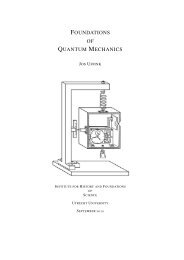Simple analytical models of glacier-climate interactions - by Prof. J ...
Simple analytical models of glacier-climate interactions - by Prof. J ...
Simple analytical models of glacier-climate interactions - by Prof. J ...
You also want an ePaper? Increase the reach of your titles
YUMPU automatically turns print PDFs into web optimized ePapers that Google loves.
1. A mass-balance model<br />
The processes governing the exchange <strong>of</strong> heat and mass between <strong>glacier</strong> surface and<br />
atmosphere contain many nonlinear features, and one may well wonder whether an<br />
<strong>analytical</strong> approach to <strong>glacier</strong> mass-balance modelling makes any sense. Let us have a<br />
look.<br />
We start <strong>by</strong> ignoring the daily cycle and assume that the daily loss <strong>of</strong> mass due to melting<br />
is determined <strong>by</strong> a potential surface energy flux ψ. Moreover, we assume that this flux<br />
has a sinusoidal shape over the year (period T):<br />
ψ = A 0 + A 1 cos 2π t/T . (1.1)<br />
The coefficients A 0 and A 1 contain both a temperature effect and a solar radiation effect.<br />
We do not include a phase shift in time (which is irrelevant) and take A 1 > 0. In Fig. 1.1<br />
eq. (1.1) is compared to the surface energy flux (daily mean values) as measured <strong>by</strong> an<br />
automatic weather station (located on the snout <strong>of</strong> the Morteratschgletscher, Switzerland).<br />
It is clear that eq. (1.1) does not work for the wintertime. However, this is not a problem<br />
because in this period little melting takes place.<br />
Ablation occurs when Ψ is positive, at a rate ψ/L m (L m is the latent heat <strong>of</strong> melting). Note<br />
that there is never any ablation when A 0 < -A 1 , and there is ablation all year round when<br />
A 0 > A 1 . To keep the model tractable accumulation has to be prescribed in a simple way.<br />
We assume that the accumulation rate is constant when ψ < 0 and zero otherwise. Fig.<br />
1.2 depicts the case when -A 1 < A 0 < A 1 . There is ablation from t = 0 onwards and it<br />
will stop at time te, given <strong>by</strong>:<br />
t e = T 2π arccos - A 0<br />
A 1<br />
. (1.2)<br />
Fig. 1.1<br />
300<br />
200<br />
total energy flux<br />
sine fit<br />
Morteratschgletscher<br />
year 2000<br />
100<br />
(W m 2 )<br />
0<br />
-100<br />
-200<br />
0 50 100 150 200 250 300 350 day<br />
3
















